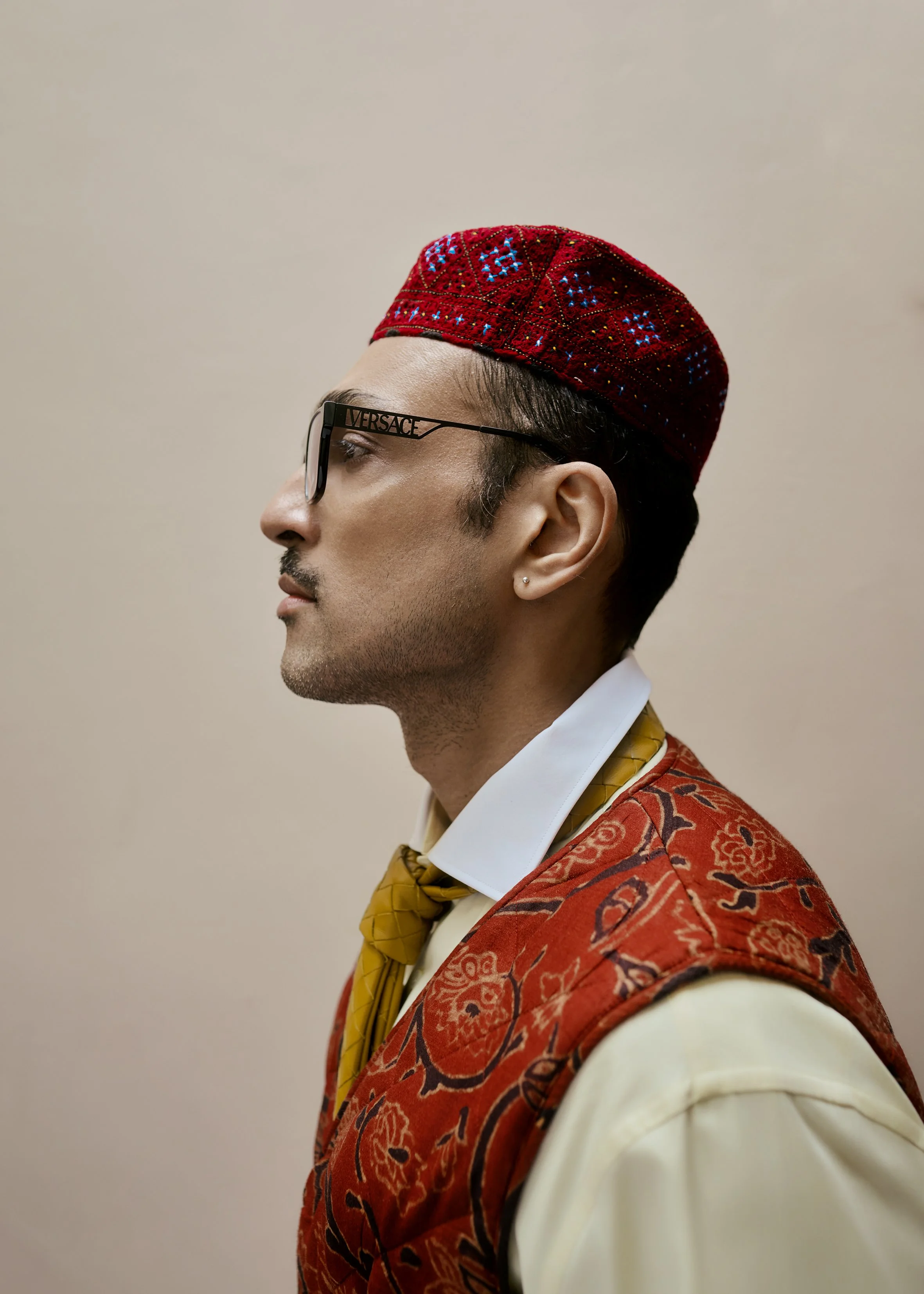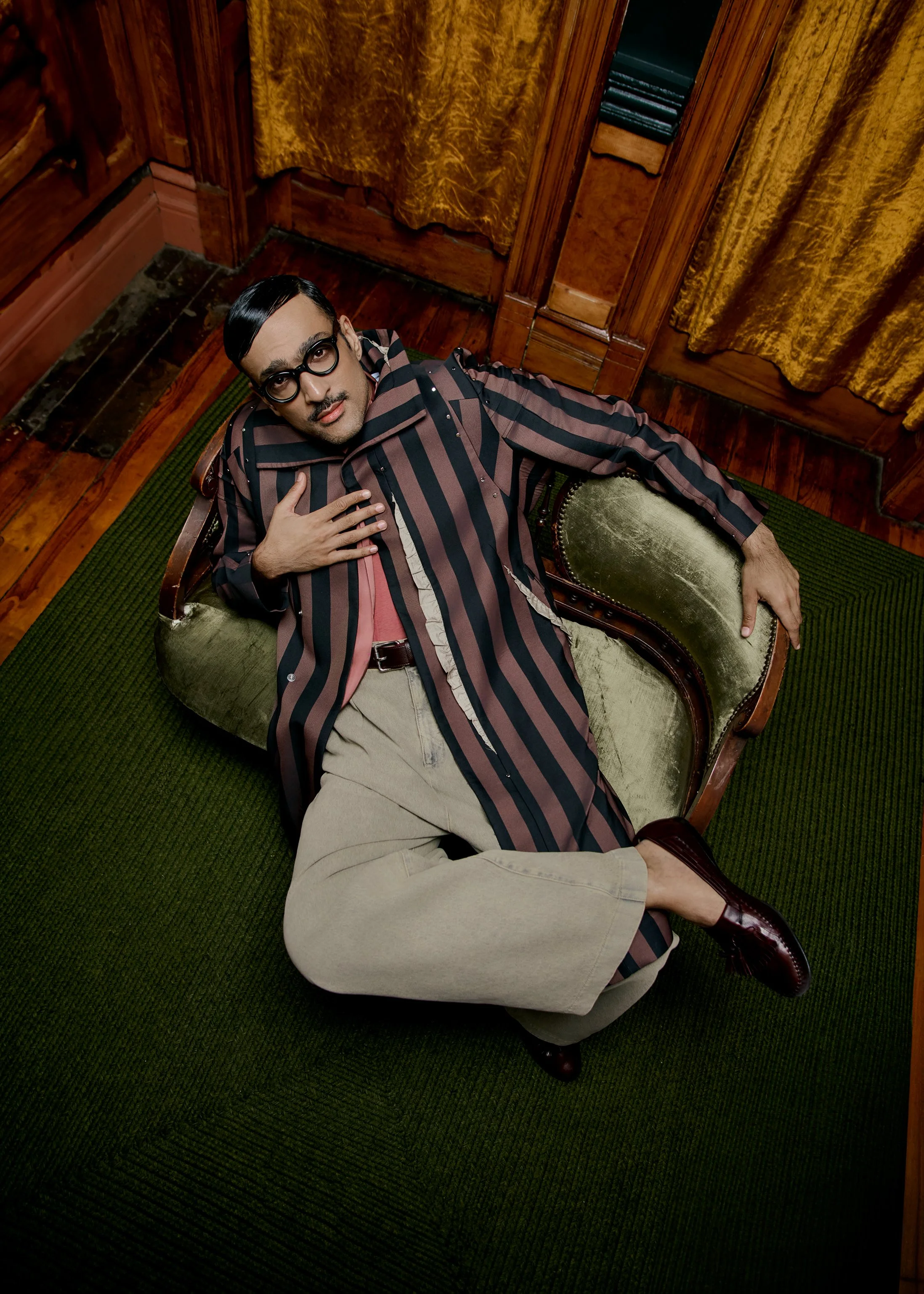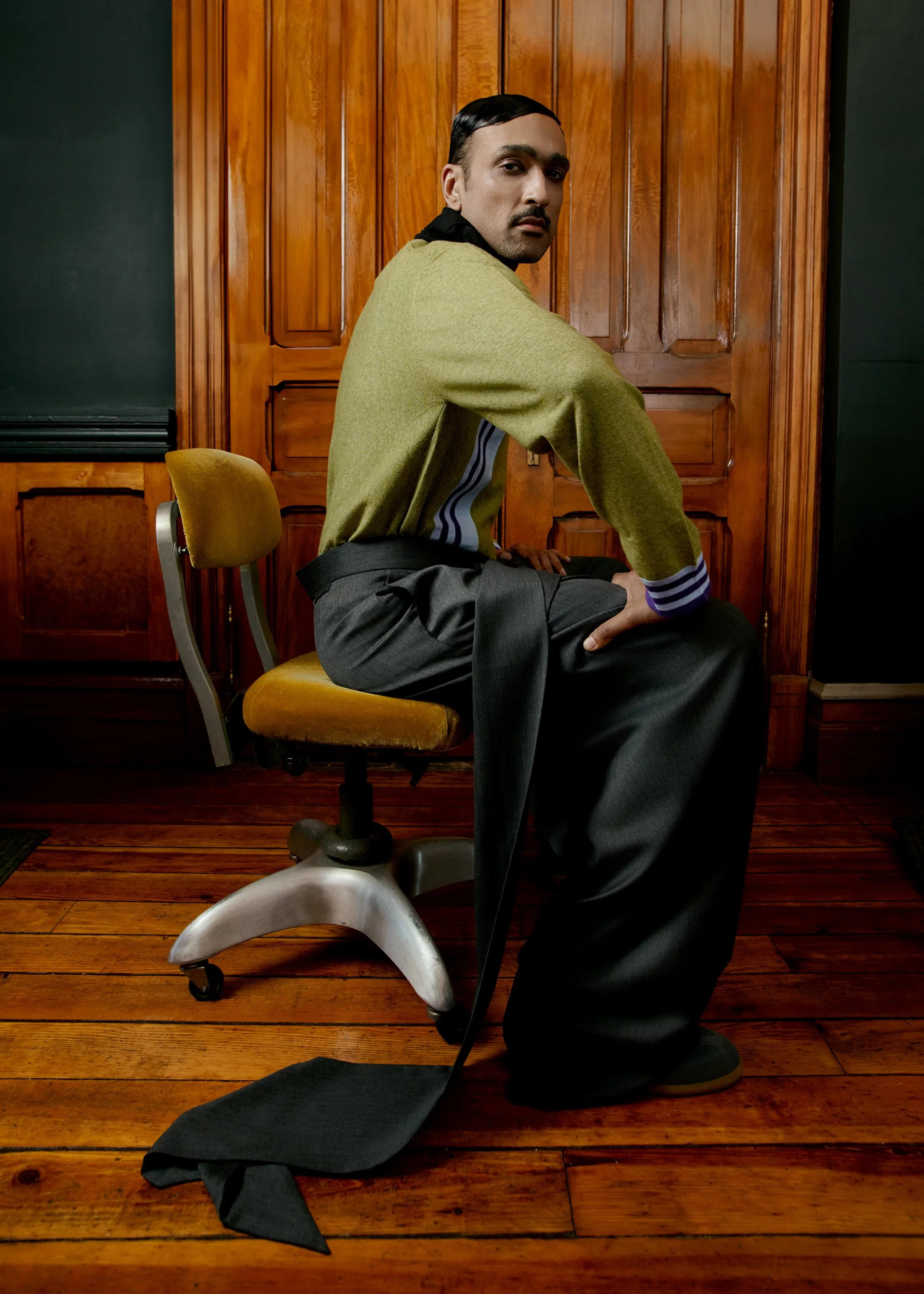Ali Sethi’s world, music is never just music. It’s a form of communion—ancestral and freaky, yet always devotional. When we sat down to talk, he was already mid-composition, working on an album that doesn’t so much fuse East and West as scramble these binaries entirely. Raised in Lahore, educated in Cambridge, MA, and trained under two masters of Indian classical music, Sethi speaks in lovely spirals—about harmony as hauntology, about Sufi shrines and club bangers, about Narendra Modi’s border regime and the algorithmic contours of too-easy-to-digest queer aesthetics. His story, like his songs, isn’t about preserving heritage but about taking the risk of drafting it over and over again. When he cites the Kamasutra and Sufjan Stevens in the same breath, the connection doesn’t jar—it lands, mostly because there’s a levity to his poetic beliefs.
Sethi’s global breakout, “Pasoori,” made with Shae Gill during lockdown, sounded like reggaeton, qawwali, and something unheard-of—a call to prayer with a backbeat. Since then, Sethi’s been chasing that elsewhere: making songs that feel like simultaneity, two things at once, like a femme whirling dervish caught in a loop. We twirled, too. We talked about flamenco as feedback, Brockhampton, Pakistani courtesans, and how to make a track sound like it’s levitating. There was a lot of discussion about dissolving borders—the sonic kind, maybe the politic kind, and the ones inside ourselves. His second album is out soon. Check out his newest single, “Tera Sitam,” to get a sneak peek of what’s in store this summer.
JACKET & SHIRT Comme Des Garçons, PANTS Issey Miyake, SHOES Talent’s Own
John Belknap: So tell me about this next album you’ve been putting together. Was there a moment that it crystallized in your brain that it would be an album? Or, was there a particular song or a feeling that you had that materialized?
Ali Sethi: In 2022, I wrote and sang this song, “Pasoori,” with Shae Gill. It came out exactly three years ago, and it was my first time writing an entirely original song. Previously, I’d done either covers or renditions—mostly ghazels and traditional Punjabi folk songs, like 2017’s “Chan Kithan.”
JB: You’ve also done some covers of club songs, too. I watched the YouTube clips of you singing the Euro club banger “Be My Lover” and [Britney Spears’] “…Baby One More Time.” That’s range.
AS: I’m trained in a style of Indian classical tradition. A lot of what we sing in that world is the standards. You might take like a medieval text, and then you learn the melodic framework and improvise. It’s similar to jazz singers. They will take standards and do interpretations with newer instrumentation. There’s a lot of experimentation that happens at the level of arrangement.
JB: Where did you grow up?
AS: I was born in Lahore, Pakistan. Then, I went to Harvard as a South Asian Studies major and hung around the English and Religion departments, the two places where I felt welcomed.
JB: I guess that you were reading, like, a lot.
AS: All the time. But basically, I started performing at Harvard. That was actually the first time—because in my slightly toxic all-boys high school in Pakistan, there was no room for classical or Baroque singing, which is what I wanted to do. There was no music society back then—there is now, but not at the time.
The first time I ever performed on a stage was in college, at the South Asian Association’s annual variety show. Singing had always been a part of my inner life until then. I performed—a fairly complex classical piece, actually—and people were like, “Wait, have you trained in this?” And I said, “No, I just love it.” They were like, “Well, you’ve got to do this every time.”
After I graduated, I wrote a novel. I had an advance. I was writing for The New York Times, writing culture pieces—very much in keeping with my liberal arts education. But what I really wanted was something else. I wanted to learn this thing I’d always loved and had an ear for. There was no book, no course you could enroll into. So, I went searching for a guru and I found one.
JACKET Max Mara, TANK Dries Van Noten, PANTS McQueen, HAT Loro Piana, SUNGLASSES Celine, SHOES Jacquemus
JB: You had two, right? The first one was [Naseeruddin] Saami—tell me more.
AS: At the outset, Saami said, “This is not a transactional relationship. You’re not going to be measured in semesters or trimesters. This is a conversation. It’s open-ended. There’s no point at which you ‘graduate’—not really.” And, that was interesting. The more I saw Saami, the deeper I went. I loved that it was an entirely different system of knowledge, a different epistemology—it was a whole other way of making sense of the world.
JB: Who was the other teacher you studied with?
AS: I studied with another wonderful musician, Farida Khanum. She’s really one of the last great voices of the women’s tradition. In North India, the men’s and women’s traditions are parallel worlds. There are entire guilds of male singers, while the women have historically been less visible.
There’s this parallel trajectory—the women singers who were crudely dubbed “courtesans” by the British. But they’re no less rigorous in their training or understanding. It’s just that for them, it’s intertwined with something else—like how the Kamasutra is intertwined with the erotic arts. Dance, music, poetry, language—it’s all part of one world
When I first met [Farida], she didn’t take me seriously. She was like, “Oh, you want to learn this music?”—as if I was just dabbling. In 2014, I even took her to India—we made a trip to her birthplace. She took me around Kolkata and pointed out these deeply storied places: A poet died under this tree, so-and-so lived there, the British used to have their office there, this singer had a legendary performance in that courtyard. It was this whole world she opened up for me.
JB: Was this after Harvard? In your early 20s?
AS: No, this was in my late 20s. Then in 2020, the pandemic hit—and that’s when something turned inside me. I started feeling this urge to synthesize. I didn’t want to dilute or dumb down anything, but I did want to take what I knew in this really rooted, deep way and mix it with the music I was hearing in my other life—the music playing in bars, at clubs. I’d just seen Call Me by Your Name, and I remember hearing Sufjan Stevens’ “Visions of Gideon,” and thinking, Oh my god, this delicate, haunting acoustic guitar sound… What would it mean to fuse that folksy American tone with Punjabi music? What kind of interference or overlap would that create?
SHIRT Prada, VEST Kartik Research, TIE Bottega Veneta, GLASSES Versace, HAT Talent’s Own
JB: Then where did that take you?
AS: I got excited about this idea of making a kind of simultaneous song—something that could feel like both worlds at once. And the first real song I made in that direction was “Pasoori.”
It was the summer of 2020, I was locked down, and I kept hearing reggaeton everywhere. Bad Bunny had exploded, Rosalía’s Motomami was in the air, Maluma, all of it—it was the post-“Despacito” moment. And I remember thinking, This beat structure, this rhythm—it’s not that different from Punjabi bhangra. They’re cousins.
And then I thought, Aha! Flamenco is the missing link. The Roma people actually originated, we now know, somewhere in India. Flamenco has deep connections to North Indian folk music, especially qawwali, which I grew up with. The handclaps, the vocal layering—it’s all there. Because when you live between cultures—when you’re multilingual, when you cross borders—you’re constantly feeling the clang of cultures. Not always a clash, but definitely a dissonance. And stepping out of the geopolitical for a moment, into the epic, the aesthetic—that can be liberating. Art can do that in ways politics can’t.
JB: I wonder why that is?
AS: I was feeling that deeply, too, because even though I’m from Pakistan, most of my audience is in India. But ever since Narendra Modi came to power, Pakistani artists have been banned from performing in India. No visas, no gigs—for almost a decade. That kind of constraint made me want to make a case for a broader South Asian sensibility—something beyond India and Pakistan, beyond Hindu/Muslim binaries, beyond this enemy/friend logic.
And while all this was swirling around me, I was also watching the queer aesthetic flourish online. These fairy-goth looks, these dreamy, androgynous styles—and I realized, this actually connects so closely to Sufi culture. You know, the dervishes with their long skirts, spinning in ecstasy outside shrines in Lahore. So I wanted to create something epic—something that enacted all of this.
That’s what “Pasoori” became for me—visually and musically. The metaphors, the production—it’s a syncretic, simultaneous identity. It feels global but also deeply local.
JACKET Kiko Kostadinov, SHIRT Rick Owens, PANTS & BELT Loewe, SHOES Gucci
JACKET Loro Piana, SHIRT Lemaire, HAT Esenshel, SUNGLASSES Gucci
JB: Do you have a favorite song from the record?
AS: There’s a bunch, but one that I really love is called “1HYM4HIM.” I made it with a producer called Romil Hemnani, whom I was introduced to maybe two years ago in L.A. At the time, I didn’t know about Romil. I didn’t know about Brockhampton, either—no idea about the music. But Romil turns out to have been one of their producers. And here’s the wild thing: He was born in Pakistan.
Anyway, he came to meet me, and he’s this young, obviously super-talented guy—amazing producer.
We ended up making a few songs together, but “1HYM4HIM” was the first one. I told him, “I’ve got this melody I’ve been working on. It’s based on a 15th-century raga, and I want to rework it—but I also want it to sound… deranged. Like reggaeton meets tabla. Like a whirling dervish.” That sensation of someone spinning and spinning, round and round, until they transcend the limits of their body through the act of music or motion. That was the feeling I was chasing.
So we made it. I sing in three octaves on that track. Romil was like, “I want to hear your voice in a way no one’s heard it before. Can you go full falsetto?” And I was like, “Yes. I can.”
JB: Working with someone like Romil must have been life-changing.
AS: Working with someone like Romil was amazing. It was freeing.
Another song from the album is called “Lovely Bukhaar.” I started that with a producer out here in Queens—Guy Furious. He’s of Indian origin, British-born, grew up in the UK, and now lives in New York. He started playing this beat, and I was like, Oh my God. This is Destiny’s Child, circa 2002 or something. I knew exactly what I wanted to do over it.
I sang this thing, and then I thought, Okay, what’s missing? What would really tie it together is flamenco guitar—this really sexy, slinky flamenco guitar. And I thought of Riya Modak. She’s a 24-year-old musician who, like me, went to Harvard.
I asked her to play over it, and she laid down this smoky, sultry line—and again, that hybrid, that mix—it wouldn’t have happened if I’d been rooted firmly in South Asia. It arises out of multiple displacements. People who are living with three or four sensibilities at once.
That’s what this project is starting to feel like: a kind of diary of multilingual, multicultural living. It’s about my own encounters with others in this tunnel, all of us hurled by history into places we didn’t expect—places our parents or grandparents never imagined for us. And we’re improvising our way through.
SHIRT & NECK PIECE Kiko Kostadinov, PANTS Dior, SNEAKERS Maison Margiela
JB: Thank you so much. That was really wonderful to hear.
AS: And I think what no one really talks about is how South Asian musical performance has always carried this element of camp. Whether it’s men, women, whoever—there’s a kind of super-sickness to it, a performative exaggeration that’s always been part of the role. The musician, traditionally, is the Shakespearean fool. The truth-teller who sneaks critique into performance. They mock the establishment, the orthodoxy, the mullah, the landowner, the pious auntie.
Those are the kinds of salon concerts I grew up around. You know—someone sitting on a carpeted floor in a drawing room with two acoustic instruments, just taking the room somewhere else entirely. The trance would start. The musician would find liberation through the trance, and then the audience would, too. There’d be nodding, weeping, someone would start dancing like they were possessed. And in that moment, the rules would fall away. People would shed their roles, their bodies, their stations in life—and just be. And then, when it ended, they’d all step back into their everyday personas, like nothing happened.
As a queer kid, that was the one space I felt completely at home. Like: This is where I can be fully inside my culture and fully free. That one sweet spot. That’s what drew me to this music in the first place—the camp of it, yes, but also the way it bridges so many things: my love of learning, of the ancient, the embroidered, the esoteric, with this big, bawdy, embodied performance style. The extremes of it.
And I think the album carries some of that. I hope it does. ❤
STORY CREDITS
PHOTOGRAPHY Jess Brohier at ALT-HOUSE, WORDS John Belknap , STYLIST Savannah Avant, ART DIRECTOR & SET DESIGNER Devanté Melton
LIGHTING DIRECTOR James Gerrish, MOVEMENT DIRECTOR Orlov Yoo, GROOMER Gabriel Barse, TALENT AGENT Lisa Gottheil
LOCATION The Artist House Project, PRODUCER Masha Spaic, CASTING DIRECTOR Muzam Agha,
LIGHTING ASSISTANT Yemi MacGregor at ALT-HOUSE, PHOTO ASSISTANT Mariame Conte, STYLING ASSISTANT Najé, SET ASSISTANT Yael Holtz
HERO IMAGE CREDITS
JACKET Loro Piana, SHIRT Lemaire, JEANS Acne Studios, HAT Esenshel, SUNGLASSES & SHOES Gucci
Read more stories













